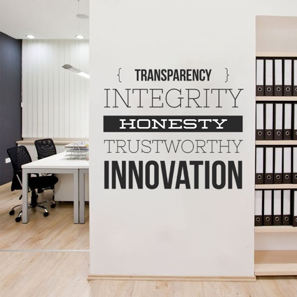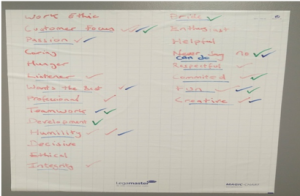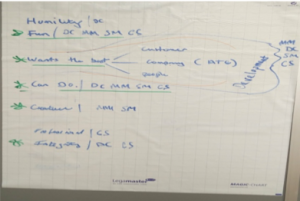
I was asked recently what core values are.
 Core values for ATG-IT are the guiding beliefs of its employees and organisation. Once you have defined your company’s core values, you can refer to them to guide every decision your company makes on a day to day basis. This makes you check that the decision you are about to make is in line with your company’s core values.
Core values for ATG-IT are the guiding beliefs of its employees and organisation. Once you have defined your company’s core values, you can refer to them to guide every decision your company makes on a day to day basis. This makes you check that the decision you are about to make is in line with your company’s core values.
We have all, at some time, worked for or know of companies where you arrive at work one day and overnight the owner of the company has placed a group of what seem to be random words on the wall. The owner then tells everybody that “These are now our company values and we all must live by them”.
I think you have to ask yourself why owners do this in the first place. I believe that in the majority of cases it’s because the owner wants more from his employees and they (wrongly) believe that if they write words on the walls such as, ‘honesty, integrity, customer first, do the right thing, helpful’ etc., to name but a few, then their employees will overnight change and start living whatever values that the owner has written on the wall. The only thing I would suggest that happens is after a few weeks they become invisible. The reason for this is that the company values haven’t been chosen correctly. They are, in fact, just the boss’s aspirations for his employees. The employees are not involved in choosing and discovering these company values, so they have no buy-in. It is, therefore, no surprise that they become invisible in a very short time, ending up being just another picture that takes up wall space.
There is, however, a way that you can involve your employees in defining your core values and get their buy-in. This is what we did at ATG-IT.
 We had the management team set aside a half day, so there was Me (Mark), Chris, David and Steve together. We all had to write down on separate pieces of paper, 3 staff members who, if we were to clone them, the business would go stratospheric. One funny thing I remember at the time was only one of the managers wrote my name down. I can remember being quite upset and angry at the time. “Obviously you want to multiply ME! Why on earth wouldn’t you?!”. I think David was just being kind or felt that he had to write my name, but to be honest you definitely don’t want multiple visionaries in any business as that would be a nightmare!
We had the management team set aside a half day, so there was Me (Mark), Chris, David and Steve together. We all had to write down on separate pieces of paper, 3 staff members who, if we were to clone them, the business would go stratospheric. One funny thing I remember at the time was only one of the managers wrote my name down. I can remember being quite upset and angry at the time. “Obviously you want to multiply ME! Why on earth wouldn’t you?!”. I think David was just being kind or felt that he had to write my name, but to be honest you definitely don’t want multiple visionaries in any business as that would be a nightmare!
Once we had done this, we collated all our lists into one list and as some of the names chosen were the same, we crossed out any duplicates. This gave us a list of 7 people that, if we cloned them, would take the business to the next level. From memory, we ended up with a list of reasons that totalled around 70. Now, if you think about it, your company core values are now somewhere inside this huge list. Obviously, you can’t have 70 core values, so it was time to start crossing out duplicates, similar reasons and reasons that just didn’t fit in. Once we had done this our reason list was now down to approximately 20. Again, still too many as they say the best number of company core values sits anywhere between 3 and 7 core values, with the optimum being 4.

We now took a photo of all the names. It’s a good idea to photograph all stages as later, showing your working out can help with employee buy-in if they can see the process you went through. We wrote the now reduced 20 reasons on to a clean board and then asked the person to explain why they had written that reason in the 1st place. Once we had gone through all 20, we were all given a different colour pen and asked to put a tick next to the reason that resonated with us the most. We had 4 choices each. We could have chosen 16 different reasons, luckily for us, we didn’t, and we had now chosen our top 7 attributes that our top employees exemplify on a day to day basis. We felt that we had completed a lot during this meeting, so we decided to finish for the day, and reconvene the next day after sleeping on the final 7 words.
 The following day we were all given time to discuss the positives and negatives and how we personally felt about each of the 7 words, finally managing to get them down to a more manageable 4 words that could potentially become our company core values. I say potentially because part of the process is that once you feel that you have discovered the core values, you need to leave them for a month, without telling anyone, just to see if you still feel the same a month later. If so then that’s great. If not, then back to the discussions. Luckily for us, we all agreed that these were really our company core values that we could all live by as they were discovered to already be alive in our company.
The following day we were all given time to discuss the positives and negatives and how we personally felt about each of the 7 words, finally managing to get them down to a more manageable 4 words that could potentially become our company core values. I say potentially because part of the process is that once you feel that you have discovered the core values, you need to leave them for a month, without telling anyone, just to see if you still feel the same a month later. If so then that’s great. If not, then back to the discussions. Luckily for us, we all agreed that these were really our company core values that we could all live by as they were discovered to already be alive in our company.
Our core values were and still are.
- Think like a customer
- Positive attitude
- Good to work with (not a knob)
- Wants the best
Ok, so now you have discovered your core values, can you go and tell everyone? Not yet! There is still more work to do if you want to get 100% buy-in from your employees. The next thing you have to do is have each of the managers that were involved in the process, take your newly defined core values and start making a list of who you have seen using this core value and what they did. Then the managers meet up and collate the notes together. You are looking for as many examples as you can for each value. We had nearly 10 examples per value and if you have good staff virtually everyone will be mentioned. Occasionally individuals aren’t mentioned but that’s a bigger issue.
 Only when you have finished this last piece can you call a company meeting. Explain to the whole company the process you went through to define your company values, going through all the stages discussed above, then show your newly defined company core values. End with the examples of where you have seen our newly discovered values in action, reading out the examples of where you have seen your existing employees living the core values.
Only when you have finished this last piece can you call a company meeting. Explain to the whole company the process you went through to define your company values, going through all the stages discussed above, then show your newly defined company core values. End with the examples of where you have seen our newly discovered values in action, reading out the examples of where you have seen your existing employees living the core values.
How do you get to buy-in to these values?
This was easy. The fact that you have shared with everyone the core value process from start to finish; it’s not just the boss’s aspirations and wall picture; you have noticed what your employees do on a daily basis and have taken the time to write it down means that everyone can see where they fit in to these values. That gives them buy in. They aren’t aspirations, they are living and breathing, already in action in the business.
Ok, so now you have them how can you use them?
As previously stated, you can use the core values when making decisions. Does the decision you are about to make fit in with your core values? At ATG we now hire and review based on our core values. At the interview stage, we ask questions based around our core values, not just competency questions about the job they are looking to do. We also hold employee monthly reviews where part of this review is based around our core values where we look to see if employees are living our values and if not, we will put a plan in place to bring them back in line. We also use them to profile potential customers as I’m sure you can imagine, if you have a customer who isn’t aligned in any way to your core values then the relationship isn’t going to work. However, when you do have a customer that is aligned to your core values and you are aligned to theirs then the relationship can only thrive.
What issues have you seen?
We didn’t really have many. Maybe I thought that they would become embedded a little quicker, although staff mostly live them naturally. Every now and then we have to remind certain staff what the values are, but because we followed the process I’ve written about it vastly reduced any issues.
What issues can happen?
The biggest one I see is if the boss doesn’t live the newly defined core values. They want everyone else too but for some reason, they think they don’t have to because ‘They’re the boss’. Let me try and give you an example. Imagine you had a customer’s widget to fix back to your company’s office and as you walk into your building, someone bumps into you and you dropped the widget, unfortunately breaking it into thousands of pieces and it’s now going to cost you many thousands of pounds to replace it. Let’s say one of your core values is honestly. If you can’t phone your customer up and tell them exactly what’s happened, even though it’s going to cost you many thousands, then your company core values aren’t worth the paper they are written on. If you are going to break your company core values for financial or any other gain, then you need to choose different core values that you can live by because if you as a boss can’t, your staff will never live by them. Especially if they see that there is one rule for the boss and another rule for them.
Is it worth all the time and effort defining your company core values?
Definitely 100% yes! There is a massive list of positives, but these are the highlights:
- Happy and engaged staff, who live the company’s core values
- we have now raised many thousands for charity
- we have won customer contracts where the potential customer saw our values in action
- less stress
- business runs smoother
- business is growing above average
- multiple Award-winning
3 key takeaways:
- Use the values that already exist in your business
- Live by your values: owners, managers lead by example
- Use your values to hire, fire and reward


You must be logged in to post a comment.